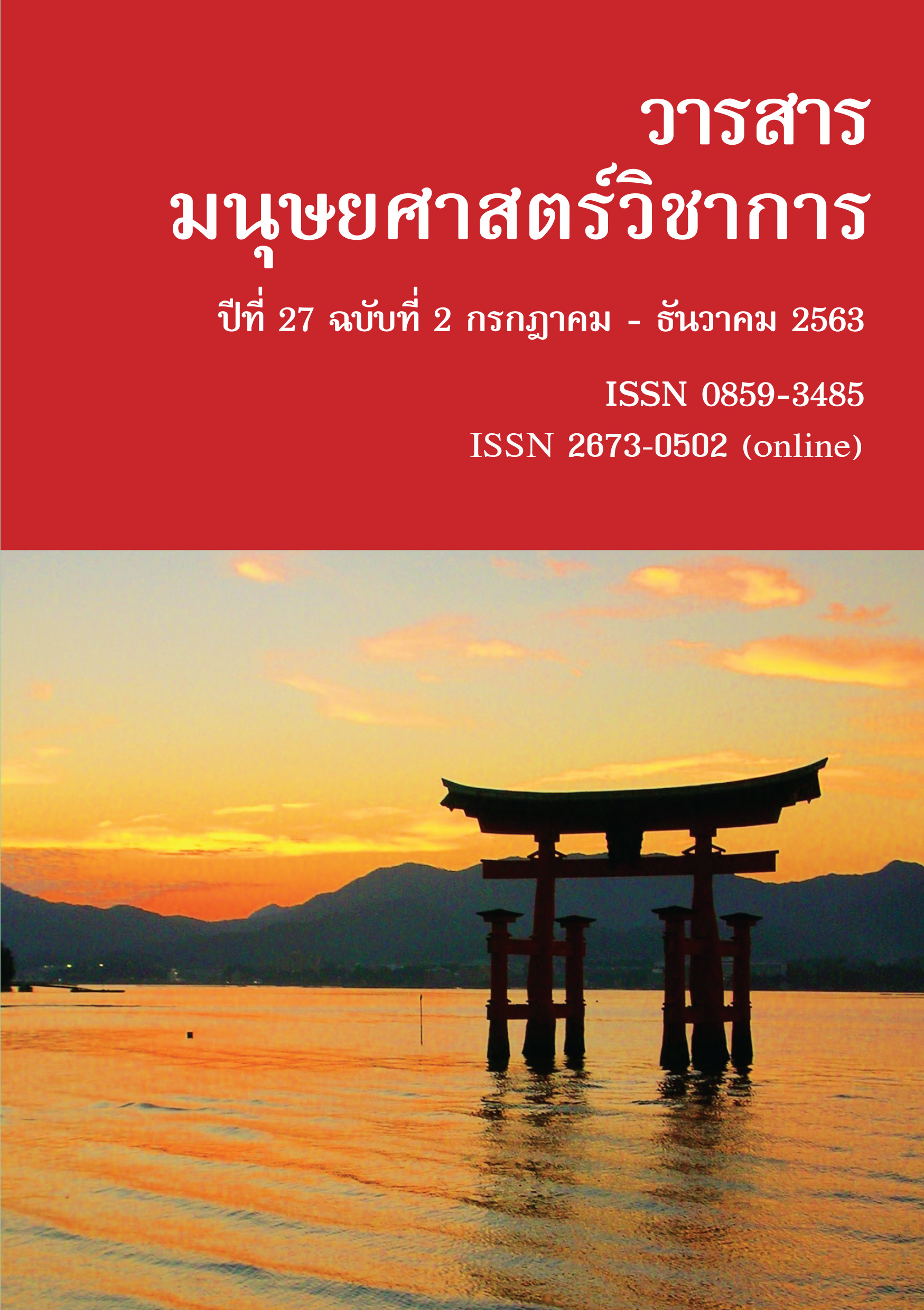Comparing the Conceptual Metaphor of “THE HEART IS A LOCATION” in Thai and Mandarin Chinese
Main Article Content
Abstract
The objective of this research article is to study the conceptual metaphor “THE HEART IS SPACE / A LOCATION” in Thai and Mandarin Chinese in accordance to theories on cognitive linguistics. The result of this research illustrates that the conceptual metaphor “THE HEART IS SPACE” in Thai and Chinese reflects both similarities and differences in the conceptual systems of the users of the two languages with regard to “heart,” In both Thai and Chinese, the concept of “heart” is understood from a perspective of space. Construing thoughts and emotions contained in the word “heart” revealed that in both languages, it is viewed as a destination or spatial location. As space and spatial relationships interact between humans and the external world, these concepts become fundamental. Space is used conceptually to understand
the concept of “heart” or concepts relating to thoughts and feelings. Thus, an abstract concept relating to thoughts and feelings thereby may be understood in a more concrete form. The conceptual metaphor “THE HEART IS SPACE” demonstrates Thai and Chinese speakers’ similar cognition of “h eart” as metaphorized into space or spatial location, but the figurative meaning of “heart” as a metaphor for thoughts and feelings differs considerably between speakers of the two languages.
Article Details
References
คฺยอง อืน ปาร์ค. (2558). มโนทัศน์ของคำว่า ใจ ในภาษาไทยเปรียบเทียบกับภาษาเกาหลี. วารสารศิลปศาสตร์, 15 (กรกฎาคม-ธันวาคม), 199-212.
ราชบัณฑิตยสถาน. (2556). พจนานุกรมฉบับราชบัณฑิตยสถาน พ.ศ. 2554. กรุงเทพฯ : นานมีบุ๊คส์พับลิเคชั่น.
Barsalou, L. W. (1999). Perceptual symbol systems. Behavioral and Brain Sciences, 22, 577-609.
Barsalou, L. W. (2008). Grounded cognition. Annual Review of Psychology, 59, 617-645.
CASS Institute of Linguistics Dictionary (中国社会科学院语言研究所词典编辑室). (2016). The Contemporary of Chinese Dictionary (现代汉语词典 (第 7 版) ). Beijng: The commercial press.
Clark, H. H., & Clark, E. V. (1977). Psychology and Language. An Introduction to psycholinguistics. New York: Harcourt Brace Jovanovich.
Fu, Ning. (2009). A Study on Monosycllabic Localizers in Modern Chinese from the Perspective of Grammaticalization (语法化视角下的现代汉语单音方位词研究). Doctoral dissertation (Linguistics and Applied Linguistics), Shandong University.
Gibbs Jr, R. W. (2006). Embodiment and cognitive science. New York: Cambridge University Press.
Gibson, E. J. (1969). Principles of Perceptual Learning and Development. New York: Appleton-Century Crofts.
Guo, Yu. (2006). A Study of the Combination “Xin+ Location Words’ with Verbs (“心+ 方位词” 与动词组合的研究). Master of Arts (Linguistics and Applied Linguistics), East China Normal University.
Kellman, P. J. (1995). Ontogenesis of Space and Motion Percepti on. In Perception of Space and Motion. In W.Epstein & S. J. Rogers (eds.), Perception of Space and Motion (2nd edition). London: Academic Press,
pp. 327-364.
Lakoff G. (1993). The Contemporary Theory of Metaphor. Metaphor and Thought. ed. by. Andrew Ortony, Cambridge: Cambridge University Press, 202-251.
Lakoff, G. & Johnson, M. (1980). Metaphors We Live By. Chicago, IL: University of Chicago Press.
Lakoff, G. & Johnson, M. (1999). Philosophy in the Flesh . New York: Basic Books.
Lakoff, G. & Johnson, M. (2003). Metaphors We Live By. Chicago: University of Chicago Press.
Lakoff, G., & Turner, M. (1989). More Than Cool Reason: A Field Guide to Poetic Metaphor. Chicago: University of Chicago Press.
Langacker, R. W. (1987). Foundations of cognitive grammar: Theoretical prerequisites (Vol. 1). Stanford university press.
Li, Wenli. (2007). System Research on the Metaphor of Human Body (人体隐喻系统研究). Master of Arts (Linguistics and Applied Linguistics), EastChina Normal University.
Lyons, J. S. (1977). Semantics (Vol. 2). London: Cambridge University Press.
Pérez, R. G. (2008). A Cross-Cultural Analysis of Heart Metaphors. Revista Alicantina de Estudios Ingleses, 21, 25-56.
Schubert T W. (2005). Your highness: Vertical positions as perceptual symbols of power. Journal of Personality and Social Psychology, 2005, 89: 1-21.
Vanparys, J. (1984). Source metaphors in English. Journal of Pragmatics, 8(3), 395-410.
Yu, N. (1998). The contemporary theory of metaphor: A perspective from Chinese (Vol. 1). John Benjamins Publishing.
Zhang, Ruihua. (2008). A Contraste Study of the Metaphor Xin & Heart-Discussing with Wu Enfeng (英汉 “心” 隐喻对比研究-与吴恩锋先生商榷). Journal of Beijing International Studies University, (8), 25-31.
Zhou, Biji. (2006). Multi-angled Study on Noun of Human Organs in Modern Chinese (现代汉语人体名词的多角度研究). Master of Arts (Chinese Linguistics), Central China Normal University.


